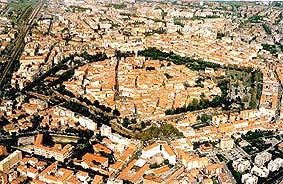


All the structures

Grosseto is the main town in Maremma, situated 10 m. above sea level on a reclaimed plain to the right of the Ombrone river, just before this flows into the Tyrrhenian Sea.
Of medieval origin, it grew after the destruction (10th century) of the nearby town of Roselle at the hands of the Saracens. Later ruled by the Aldobrandeschis in 1336 it came under the dominion of Siena. After the defeat of Siena by Florence, in 1569, it shared the fortunes of the Grand Duchy of Tuscany. Grosseto subsequently declined following a malaria epidemic, but began to recover after reclamation of the surrounding area, starting in the second half of the 18th century, continuing in the 19th and in the present century (1930). It was heavily bombed during the last War.
The town is largely modern in appearance, apart from its centre, inside a circle of 16th century hexagonal walls, transformed in the 19th century into tree-lined bastions.
Monuments: Fortezza Medicea (16th century), church of S. Francesco (13th century, Gothic façade, inside a Cross painted by Duccio di Buoninsegna), Duomo (13th-14th century), the bastion walls (1574). Nearby Montepescali is a small village of environmental interest.
The local economy is based mostly on commerce and processing of agricultural produce from the fertile hinterland (cereals, vegetables, livestock); there are some engineering and building material companies. Tourism linked to the nearby Marina di Grosseto is reasonably important.
Cultural Institutions: State Archives, Chellian library, Archeological Museum, Civic Natural History Museum, Diocesan Museum of Religious Art (paintings of the 13th-17th century Sienese school), Maremma Historical Society.
In the Province: Vetulonia (Etruscan necropolis), Orbetello, Castiglione della Pescaia (seaside resort), Follonica, Gavorrano (mining), Massa Marittima (city of art).